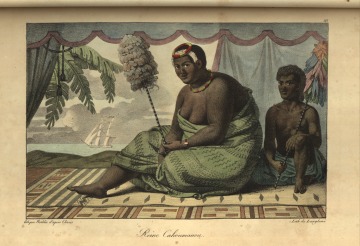1819: Hawaiian queen lifts kapu, or taboos
Before the arrival of Europeans in the 18th century, an extensive system of taboos, or kapu, regulates Hawaiian life. Queen Ka‘ahumanu, the favorite wife of Kamehameha I, who shared some of the authority to rule with his son Liholiho (Kamehameha II) after his death, is responsible for ending kapu to instead promote Christian values. Many of the Hawaiian temples known as heiau are destroyed or abandoned as a result.
- Theme
- Land and Water, Native Rights
- Region
- Hawai‘i
Heiau (temple) at Kealakekua Bay, Hawai'i, 1782, engraved by W. Walker based on an illustration by William Ellis, an English missionary and naturalist who traveled on the third voyage of Captain James Cook to the Hawaiian Islands
Hale-o-Keawe heiau (temple), Hawai'i, 1823 by William Ellis, an English missionary and naturalist who traveled on the third voyage of Captain James Cook to the Hawaiian Islands
Courtesy Bernice Pauahi Bishop Museum
An Anglo-European artist’s depiction of Queen Ka‘ahumanu
Courtesy Hawai‘i State Archives
Portrait of King Kamehameha II, by English artist John Hayter, 1824
Courtesy Hawai‘i State Archives



